As Hurricane Milton barrels toward central Florida, experts warn that Tampa is the most vulnerable place, with a wide continental shelf and shallow waters that can exacerbate the storm surge. The developed coastline around Tampa Bay, home to 3.5 million people, means infrastructure is susceptible to the surge. The recent unrepaired damage from Hurricane Helene also poses a threat, as debris could become dangerous projectiles. Furthermore, misinformation and disaster fatigue add to the challenges facing the region. Despite efforts to reinforce critical infrastructure, residents must prepare for extensive destruction from this Category 4 storm. Hurricane preparedness and storm surge are crucial for Tampa’s survival.

The Vulnerability of Tampa Bay
Tampa Bay’s unique geography makes it particularly susceptible to the devastating effects of Hurricane Milton. According to Q. Jim Chen, professor of civil and environmental engineering and marine and environmental sciences at Northeastern University, the wide continental shelf off the west coast of Florida allows wind to easily whip up shallow water and push it into the bay, which is also shallow. This combination of factors exacerbates the storm surge, posing a significant threat to the developed coastline around the bay.
Moreover, the unrepaired recent damage from Hurricane Helene adds to the danger. Chen explains that debris from the previous storm could become “like weapons” and “missiles” moving around, further endangering the 3.5 million residents in the metro Tampa area.
Misinformation and Disaster Fatigue Compound the Challenges
According to Daniel Aldrich, professor of political science and public policy at Northeastern University and co-director of the Global Resilience Institute, an “active disinformation campaign” is currently undermining the typical response processes that would normally be apolitical. This loss of trust means that fewer people may be willing to listen to and cooperate with critical information and instructions from authorities like FEMA.
Additionally, Aldrich’s research shows that “disaster fatigue” is setting in among donors, volunteers, and others as the frequency of multiple “shocks” in the area increases. This “polycrisis” situation, where multiple challenges occur simultaneously, further strains the resources and resilience of the local community.
Preparing for an Extremely Dangerous Hurricane
The National Hurricane Center has reported that Hurricane Milton has maximum sustained winds of about 150 mph and is moving across the warm waters of the Gulf of Mexico toward the Tampa area. The hurricane is currently a Category 4 storm, and while fluctuations in intensity are expected, it is forecast to remain an extremely dangerous hurricane through landfall in Florida.
The hurricane is expected to come ashore late Wednesday or early Thursday, bringing with it a storm surge of 10 to 15 feet. The state of Florida has already issued mandatory evacuations for parts of Tampa Bay, and critical infrastructure such as hospitals and hurricane shelters have been reinforced with barriers for protection. However, the scale of the challenge means that homes, roads, and bridges along the low-lying, developed coastline remain at particular risk from the storm surge. Older infrastructure is also more vulnerable, as building standards have been updated since Hurricane Andrew made landfall in 1992.
